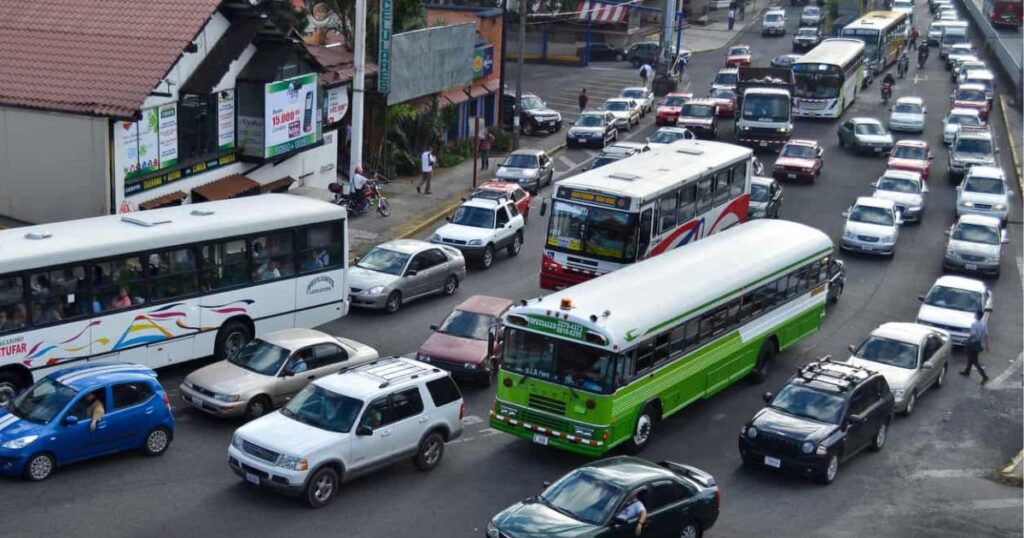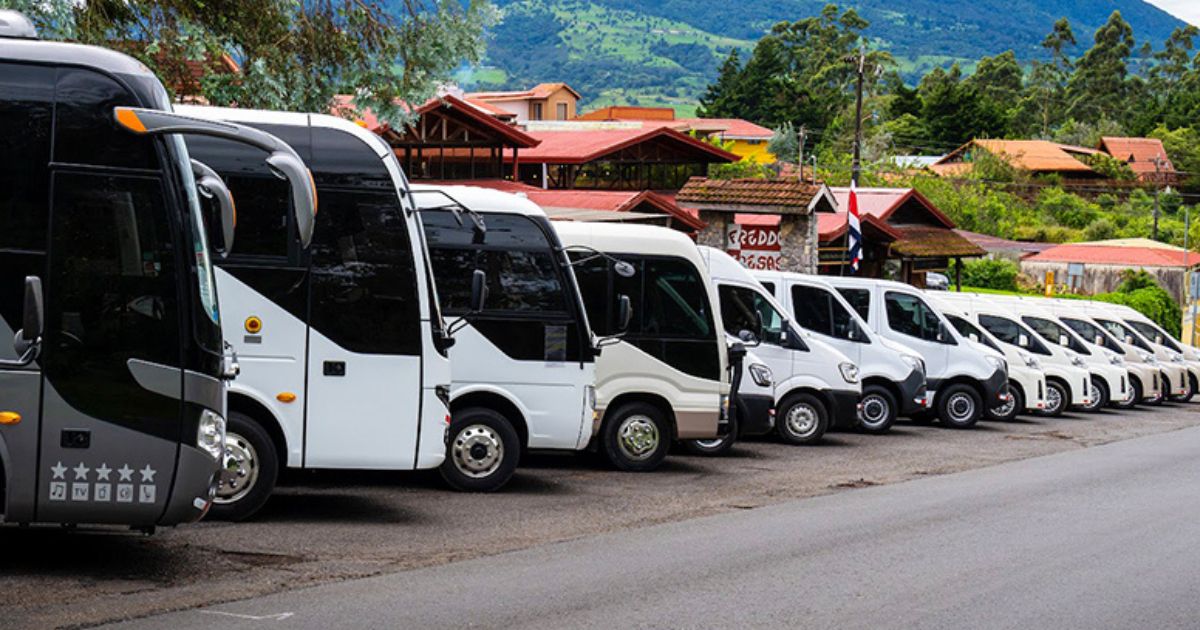Traveling in Costa Rica offers so much more than just beautiful scenery and adventure. It’s also an opportunity to explore the country on a budget. For many visitors, the thought of navigating public transportation can be daunting. However, it can be a smart and economical choice. Costa Rica public transportation system is well-developed and efficient, making it easier than ever to experience everything this stunning country has to offer.
Riding the bus or taking a shuttle can provide a unique glimpse into daily life in Costa Rica. You’ll have the chance to encounter friendly locals, sample authentic street food, and maybe even pick up a few Spanish phrases along the way. With routes connecting popular tourist spots and hidden gems alike, public transportation allows you to travel with ease while keeping your wallet happy. There’s something rewarding about using local transport and immersing yourself in the culture.
In this guide, we’ll delve into the ins and outs of public transportation options in Costa Rica. From navigating the bus system to tips for a smooth journey, we’ll ensure you feel confident in your travel choices. So, let’s explore how you can experience the beauty and vibrancy of Costa Rica without spending a fortune.

Understanding Costa Rica Public Transportation System
Costa Rica has a public transportation system that offers a blend of affordability, accessibility, and cultural richness. It caters not only to the locals but also to tourists who want to explore the beautiful landscapes of the country without the burden of renting a car. Here are some key features that make the public transportation system unique:
Buses
Buses form the backbone of the public transport network in Costa Rica. They connect almost every town and city, making it easy for travelers to reach popular tourist destinations like Monteverde, Arenal, and Manuel Antonio. Buses vary in size and comfort but are generally reliable.
Comfortable Travel
Many buses are modern and air-conditioned, especially the ones catering to long-distance travel. This is a welcome feature, particularly during the hot days. Travelers can sit back and enjoy the journey while enjoying the stunning views of mountains, coastlines, and lush rainforests.
Affordable Fares
Cost is a significant advantage of using public transportation. A bus ride from San José to a coastal town can cost just a few dollars. This affordability makes it easy for backpackers, families, and budget travelers to explore more of the country without overspending.
Punctuality
While bus schedules can occasionally vary due to road conditions and traffic, many buses are generally punctual. In major cities, buses might come every 15-30 minutes, allowing travelers to plan their day effectively. Arriving early at the bus station can also provide the best chance for a good seat.
Accessibility
In larger cities like San José, there are extensive bus routes that cover a significant area. This makes getting around the city convenient. Public transportation is a great alternative to driving, especially for those unfamiliar with local roads. Local buses are often equipped with digital displays to help guide passengers.
Cultural Experience
Using public transport is more than just getting from point A to point B; it’s an immersive experience. Buses often serve as hubs for locals, providing a unique opportunity to interact with Costa Ricans. You can hear stories, see local customs, and even buy snacks from vendors who board during stops.
The Costa Rica public transportation system is efficient, economical, and deeply embedded in the cultural fabric of the country. It offers a vibrant way to travel while reducing your environmental footprint. By using it, you’re not only navigating the country but also experiencing its heart and soul.

The Benefits of Using Public Transportation in Costa Rica
Public transportation in Costa Rica offers travelers an enriching experience that goes beyond the mere convenience of getting from one place to another. With a mix of affordability, accessibility, and opportunities for cultural immersion, this mode of travel can greatly enhance your journey through the vibrant landscapes and communities of Costa Rica. In addition to practical advantages, using public transportation can lead to unexpected adventures and connections.
Let’s explore the various benefits of utilizing public transportation during your travel:
Cost-Effective Travel
One of the standout advantages of public transportation is its affordability. Bus fares are generally low, making it easy to travel long distances without breaking the bank. This cost-efficiency allows you to allocate your funds to other experiences, such as dining at local restaurants or engaging in tours that showcase Costa Rica’s natural beauty.
Reduced Travel Stress
Navigating unfamiliar roads can be daunting, especially if you’re not accustomed to local driving conditions. By using public transport, you can avoid the stress of driving, parking, and finding your way. Instead, you can relax and enjoy the scenic views, allowing for a more pleasant journey.
Eco-Friendliness
Selecting public transportation contributes to sustainability. Using buses and shared taxis helps reduce individual car emissions, which supports Costa Rica’s commitment to environmental conservation. By choosing this option, you are doing your part to help protect the natural beauty of the country.
Increased Safety
Public transportation in Costa Rica is often perceived as a safer option for travelers. Buses are operated by professionals familiar with the roads and traffic patterns, reducing the chances of accidents. This can be especially reassuring for those who may be worried about navigating in a foreign environment.
Opportunity for Socialization
Public transport encourages social interactions among passengers. Sharing a ride with locals and fellow travelers can result in meaningful conversations and new friendships. These connections can enrich your travel experience and provide a broader perspective on Costa Rican culture.
Accessibility for All
Increasingly, Costa Rica public transportation system is becoming more inclusive, with efforts to assist travelers with mobility challenges. Many cities have made strides to ensure that their transport options cater to a wide range of needs, providing greater accessibility for everyone.
Local Insights
Riding public transport allows you to mix with locals, providing a unique opportunity to gain insights about the country. Conversations with Costa Ricans can lead to recommendations for places to visit, foods to try, and cultural practices to observe—insights that you may not discover through traditional tourist routes.
Definitely, public transportation in Costa Rica is more than just a practical means of travel. It provides a wealth of benefits that improve both budgeting and immersion, allowing you to connect with the country’s culture and communities in ways that other forms of transportation may not.
Types of Costa Rica Public Transportation Available
Public transportation in Costa Rica is both accessible and efficient, making it a popular choice among both locals and tourists. With a range of options available, you can easily travel from bustling cities to serene beaches or lush rainforests. Each mode of transport has its unique features, advantages, and charm, offering travelers a chance to experience the country in different ways.
Here’s an overview of the different types of public transportation available in Costa Rica:
Buses
Costa Rica features an extensive bus network for almost every part of the country, making it extremely practical and economical for traveling locals and tourists. Even from the most urban metropolises to the coastal beach towns and mountainous landscapes, the bus system in Costa Rica is highly advanced, offering affordable and reasonably frequent service to most points. Intercity buses are generally well-arranged, especially in connections between main tourist sites such as from San José to the cloud forests of Monteverde or the coastal beaches of Manuel Antonio.
Buses are also used for general city purposes. They travel a regular route, which includes visiting business districts, residential areas, and local points of interest. Intercity buses link larger cities to smaller towns and popular tourism areas, but they are often set-schedule buses that offer varying degrees of comfort, including air-conditioned services for longer trips. Bus travel is very economical — it is also an experience in itself, observing life around Costa Rica.
Here are the reasons to ride a bus in Costa Rica:
- Bus fares are budget-friendly, making it one of the cheapest ways to travel around the country.
- Buses connect almost every major city, town, and tourist attraction.
- Buses are often filled with locals, providing an opportunity to experience Costa Rican culture firsthand.
- Riding the bus allows you to enjoy the diverse landscapes of Costa Rica without worrying about navigation.
- This can be a stress-free way to travel, especially in unfamiliar areas, because you don’t have to worry about traffic, parking, or confusing road signs.
Taxis
Taxis are a ubiquitous mode of transport in the entire country of Costa Rica, especially within the cities. They serve as one of the most convenient and accessible modes of transport for visitors. Official taxis are typically red and have a yellow triangle on the side; most taxi drivers use a maría (meter) to calculate the fare. They are ideal for short urban trips or to transfer passengers from bus terminals to their destination, such as a hotel or nearby attraction. Taxis are also accessible in rural areas, where availability and service may be less frequent.
Here are the reasons to ride a taxi in Costa Rica:
- Taxis take you directly to your destination without requiring transfers.
- Taxis are readily available in cities, towns, and tourist areas.
- Most taxis are air-conditioned, providing a comfortable ride.
- Taxi drivers often have extensive local knowledge.
- Taxis in Costa Rica are generally considered safe, with well-regulated services.
- Taxis can accommodate specific requests, such as stopping at multiple locations.
- Taxis are available late at night, making them a reliable option for returning to your accommodations after evening outings or activities.
Rideshare Services
Ridesharing services are also gaining popularity, but they are mainly confined to San José and a few other large cities. Whereas within the areas where ride sharing is available, it mostly would be cheaper than taking taxis, with a bonus being the transparency of fare costs and cashless payments as well. For those who happen to stay in San Jose or are to travel around from the airport, ridesharing can be more than a good choice, but outside the capital, all other options for rapid mobility are traditional taxis, either as the only available taxi or the most accessible alternative.
Here are the reasons to ride rideshare services in Costa Rica:
- Rideshare apps are easy to use, allowing you to request a ride with just a few taps on your phone.
- Fares are calculated before you book the ride, so you know what you’ll pay.
- Rideshare services often include safety measures such as driver ratings and ride tracking.
- Many drivers are proficient in English, making communication easier for non-Spanish speakers.
- Rideshare vehicles are typically newer and well-maintained.
- Rideshare services generally have shorter wait times compared to traditional taxis.
- You can be picked up and dropped off at precise locations rather than set taxi stands.
Minibuses
Minibuses, often referred to as shuttle services, are a popular mode of public transportation in Costa Rica, catering primarily to tourists traveling between major destinations. These comfortable vehicles typically have fewer passengers than standard buses, allowing for a more relaxed travel experience. Minibuses often provide door-to-door service from hotels to attractions, making them highly convenient for travelers unfamiliar with the area. They are especially valuable for shuttling between popular sites such as Arenal Volcano, Monteverde, and the beaches along the Pacific coast.
While advanced booking is generally required, the moderate cost and enhanced comfort make minibuses an appealing option for those seeking a balance between private transport and public options.
Here are the reasons to ride a minibus in Costa Rica:
- Minibuses often provide direct routes between popular tourist destinations, making travel easy.
- Compared to standard public buses, minibuses typically have fewer passengers and more spacious seating.
- Minibuses travel through beautiful landscapes, allowing you to enjoy Costa Rica’s stunning scenery along the way.
- Drivers and guides are often knowledgeable about local attractions and can provide helpful tips.
- Minibuses can be an affordable option when considering comfort and convenience.
- Minibus services often include help with loading and unloading your luggage, making the process smoother.

Local Trains
Costa Rica has a very limited commuter rail network within the Greater San José area. Though not as common, these trains are a relatively effective, environmentally friendly means of travel for locals and tourists alike traveling between towns just outside the capital. Many locals use them as an inexpensive and reliable form of transportation through urban centers, traveling between San José and other nearby towns like Heredia and Cartago on a daily basis. The train is a great option for people staying in San José who want to explore the neighboring towns without having to rely on buses or taxis, offering a relaxing, affordable, and environment-friendly alternative for short journeys.
Here are the reasons to ride a local train in Costa Rica:
- Trains allow you to sit back and relax without the stress of navigation or traffic.
- Traveling by train can offer a glimpse into everyday life in Costa Rica.
- Trains generally provide more spacious seating than buses, making for a comfortable travel experience.
- Taking the train is a less conventional mode of transport, appealing to those wanting to experience something different.
- Trains often pass through lush greenery, providing picturesque scenery that isn’t always visible from the road.
Boats and Ferries
Boats and ferries are essential components of Costa Rica’s public transportation system, particularly for reaching islands and remote coastal areas. They connect the mainland to popular destinations such as Tortuga Island, the Nicoya Peninsula, and various other coastal locations. These services offer travelers a unique opportunity to enjoy stunning views of the coastline while also providing essential transport for both tourists and locals.
Ferry rides can be an adventure in themselves, often offering passengers a chance to spot wildlife, such as dolphins and sea birds, along the journey. This mode of transportation expands access to beautiful beaches and less-traveled regions that are not easily reachable by road.
In addition to enhancing accessibility, boats and ferries often contribute to a more leisurely travel experience. With comfortable seating and the option to enjoy refreshing sea breezes, passengers can relax as they cruise over the water. The schedules may vary, especially during peak tourist seasons or certain weather conditions, so it’s advisable for travelers to check schedules and book in advance when possible.
Here are the reasons to ride a boat and ferry in Costa Rica:
- Ferries connect the mainland to various islands and coastal destinations. In fact, many stunning locations, like Tortuga Island and the Nicoya Peninsula, are only accessible by boat.
- Traveling by water offers breathtaking vistas of the coastline, islands, and lush greenery.
- Boat rides often provide opportunities to see marine life, such as dolphins, sea turtles, and even whales.
- Ferries often have a more leisurely pace compared to land transportation.
- Boats and ferries offer convenient connections between major tourist destinations.
- Ferry tickets are generally affordable, providing a budget-friendly way to travel between destinations.
- The experience of navigating the waters adds an adventurous touch to your trip.
Costa Rica offers a wide array of public transportation options to suit various travel needs and preferences. Whether you choose the classic bus system for an economical commute or opt for the convenience of taxis and rideshare services, each mode of transport in Costa Rica provides its unique benefits and experiences.
Destinations Easily Accessible by Public Transport
Costa Rica is a treasure trove of stunning landscapes, vibrant cities, and incredible biodiversity. Getting around the country is both easy and convenient, thanks to a robust public transportation system. From local buses to rideshare services, various options connect you to the country’s most popular destinations. Understanding where you can go using public transport only enhances your travel experience. So, let’s explore them below:
Buses
Costa Rica’s extensive bus network makes it easy to reach a variety of incredible destinations throughout the country. In fact, public buses provide an affordable and convenient way to experience the diverse landscapes and attractions Costa Rica has to offer. Here are some noteworthy destinations you can easily access by bus:
San José
– The capital city and primary transportation hub.
– A great starting point for various adventures across the country.
Arenal Volcano
– A popular destination known for its stunning volcano and surrounding hot springs.
– Access to numerous activities like hiking, zip-lining, and relaxing in natural hot springs.
La Fortuna
– Located near Arenal Volcano, it’s famous for its waterfalls and adventure sports.
– Buses run frequently from San José or Liberia.
Monteverde
– Known for its cloud forests and biodiversity.
– Accessible by bus from both San José and La Fortuna.
Manuel Antonio
– A coastal destination with beautiful beaches and a national park.
– Buses run from San José and Quepos, making it easy to get there.
Tamarindo
– A lively beach town popular with surfers and backpackers.
– Regular buses connect it with San José, Liberia, and other beach towns.
Jacó
– A bustling beach town famous for surfing and nightlife.
– Buses frequently run from San José and offer easy access for day trips or longer stays.
Taxis
Taxis in Costa Rica offer a convenient and efficient way to travel between popular destinations. They provide the flexibility to travel on your own schedule, making them an excellent choice for both tourists and locals. Here are some popular destinations that are easily accessible by taxi in Costa Rica:
San José
– The capital city is a hub of culture, dining, and history. Key attractions include the National Theatre, the Gold Museum, and various vibrant markets.
La Fortuna
– This charming town near Arenal Volcano is famous for its hot springs and waterfalls, making it a hot spot for relaxation and outdoor activities.
Monteverde Cloud Forest
– Known for its unique ecosystems, Monteverde is perfect for nature lovers wanting to explore hiking trails and zip-lining experiences. Taxis can help you navigate the winding roads to this destination.
Manuel Antonio National Park
– A must-visit for wildlife enthusiasts, this national park features stunning beaches and rich biodiversity. Taxis can take you directly to the park entrance or local hotels.
Tamarindo
– A popular beach town in Guanacaste known for surfing, nightlife, and pristine beaches. It’s easily accessible via taxi from nearby airports and towns.
Jacó Beach
– Known for its lively atmosphere, Jacó is a favorite among surfers and party-goers. Taxis can transport you to this coastal town in about an hour from San José.
Guanacaste Beaches
– Various beautiful beaches like Playa Conchal, Playa Flamingo, and Playa Hermosa are within easy reach by taxi, offering stunning coastal views and relaxation.
Rideshare Services
Rideshare services offer a convenient way to navigate urban areas and connect to various popular destinations without the hassle of public transportation schedules. With just a few taps on your smartphone, you can easily arrange a ride to explore the country. Here’s a list of destinations that are easily accessible by rideshare services in Costa Rica:
San José
– The capital city is a hub of culture, shopping, and dining. Rideshares can take you to museums, restaurants, and local markets.
Alajuela
– Home to Juan Santamaría International Airport, Alajuela is also known for its parks and local attractions.
Heredia
– A charming city that features coffee plantations, parks, and a lively market scene. Rideshares make it easy to explore its attractions.
Arenal Volcano National Park
– The park is a popular tourist spot famous for its iconic volcano and hot springs. Many rideshare drivers are willing to take you there, especially from La Fortuna.
Manuel Antonio National Park
– A stunning park known for its beautiful beaches and wildlife. Rideshare services can help you get there from nearby towns.
Monteverde
– This cloud forest destination is famous for its biodiversity and eco-tourism experiences. While a longer ride, rideshare services can facilitate your travel from nearby towns.
Santa Teresa
– A beautiful beach town known for its laid-back vibe, surf spots, and yoga retreats. Rideshare services can help you navigate to this more remote destination.
Guanacaste Beaches
– Beaches like Playa Conchal, Playa Flamingo, and Playa Hermosa are popular for their beauty and activities. Rideshare services often operate in these tourist areas.
Minibuses
Minibuses provide a reliable means of transportation between major cities and popular tourist destinations, making it easy to explore the country’s rich offerings. These services usually offer door-to-door options and can accommodate both groups and individual travelers. Here are some key destinations that are easily accessible by minibuses:
San José
– The capital city is a common starting point for many travelers. It offers museums, vibrant markets, and cultural attractions.
Puerto Viejo
– Located on the Caribbean coast, this laid-back town is known for its beautiful beaches, reggae music, and vibrant Afro-Caribbean culture.
Osa Peninsula
– For those interested in wildlife viewing and adventure, destinations like Corcovado National Park are accessible via shuttle services.
Quepos
– Often used as a gateway to Manuel Antonio, Quepos offers a lively atmosphere and dining options near the coast.
Jaco
– A bustling beach town famous for its surfing conditions, vibrant nightlife, and nearby national parks.
Nicoya Peninsula
– Access to beautiful beach destinations such as Santa Teresa, Montezuma, and Mal País, popular with surfers and sunseekers.
Local Trains
The local trains primarily operate in the Central Valley, providing services that link major cities and some scenic areas. This mode of transportation is both economical and offers picturesque views of the landscape as you travel. Here are some destinations easily accessible by local trains:
San José
– The capital city and the main hub for train services. It’s a bustling area filled with culture, markets, and historical sites.
Alajuela
– Close to the international airport, this city offers a local flavor with its parks and the nearby Poás Volcano.
Heredia
– Popular for its charming colonial architecture and vibrant coffee culture. It’s a gateway to beautiful mountainous areas.
Santo Domingo
– A suburb of San José, this area is famous with locals and offers a relaxed atmosphere with access to parks and local dining.
Pérez Zeledón
– While not directly on the train route, it’s accessible via a combination of train and bus, offering access to the stunning landscapes of southern Costa Rica.
Curridabat
– Nearby San José, this area is emerging as a residential and cultural spot featuring parks and local events.
Cartago
– A historic city that is easily reached by train, known for its stunning basilica and rich cultural heritage.

Boats and Ferries
Costa Rica’s picturesque coastlines and numerous islands make boat and ferry travel an exciting way to explore its natural beauty. Ferries provide essential connections between the mainland and various islands, offering scenic views of the ocean and surrounding landscapes. Here are some popular destinations that you can easily reach by boat or ferry:
Tortuga Island
– Known for its stunning beaches and crystal-clear waters, Tortuga Island is a popular destination for snorkeling and diving. Ferries depart from Puntarenas and offer a quick way to access this tropical paradise.
Nicoya Peninsula
– The Nicoya Peninsula is a vast area with several stunning beaches and towns, such as Santa Teresa and Montezuma. Ferries from Puntarenas and neighboring cities make it easy to reach this beloved surf and wellness hotspot.
San Lucas Island
– Previously a penal colony, San Lucas Island is steeped in history and natural beauty. Ferries operate from Puntarenas, allowing visitors to explore the island’s hiking trails, wildlife, and old ruins.
Isla del Caño
– A small island renowned for its rich marine life, Isla del Caño is a top spot for diving and snorkeling. Accessible by boat from Sierpe or Drake Bay, the island offers pristine beaches and opportunities to see diverse wildlife.
Golfo Dulce
– This serene gulf is bordered by the Osa Peninsula and is home to several small towns like Puerto Jiménez. Boats take travelers to various destinations within the gulf, including opportunities for whale watching and exploring beautiful beaches.
Chira Island
– Chira Island is located in the Gulf of Nicoya and is a great spot for experiencing local culture and fishing. Ferries from Puntarenas provide easy access to this peaceful island with beautiful landscapes and wildlife.
Tips on How to Navigate Costa Rica Public Transportation
Navigating Costa Rica’s public transportation system can be a rewarding experience, allowing travelers to explore the country conveniently and affordably. However, it’s helpful to have some tips in mind to make the journey smoother and more enjoyable. Here are some tips you can follow to effectively utilize public transportation in Costa Rica:
Learn Basic Spanish
While many locals speak some English, knowing a few basic Spanish phrases can enhance your experience. Simple greetings, asking for directions, or understanding fare prices can go a long way. Locals often appreciate this effort, and it can lead to more enriching interactions.
Plan Your Routes in Advance
Before heading out, familiarize yourself with the bus routes and schedules. Most major bus companies provide this information online or at stations. Having a clear plan will help ensure you reach your destination without unnecessary delays.
Carry Small Change
Public transportation in Costa Rica often requires small denominations for fares. Having small bills and coins will make purchasing tickets easier and help avoid complications if the driver cannot give change. It’s always good practice to check the fare in advance and pay accordingly.
Use Reliable Transportation Apps
For rideshare services, make sure to download the app before your trip. It provides not only convenience in hailing rides but also helps you navigate during your travels. In addition, apps like Google Maps can help you understand public transport routes and schedules more easily.
Don’t Hesitate to Ask for Help
If you’re unsure about your route or where to catch your bus, don’t hesitate to ask locals for assistance. Most Costa Ricans are friendly and willing to help travelers navigate the public transport system. Being open to asking for help can lead to new conversations and insights about the area.
Pack Light for Transit
If you’re planning to use public transport extensively, consider packing light. This makes it easier to maneuver through bus stations and trains and manage your belongings. A smaller bag will also help you maximize comfort during your travels.
Challenges of Using Public Transportation
While public transportation in Costa Rica is a convenient option for many travelers, it does come with its own set of challenges. Understanding these challenges can help prepare you better for your journey. Here are some of the key challenges to consider:
Inconsistent Schedules
Bus and shuttle schedules may not always be reliable. Buses can arrive late or experience cancellations, leaving travelers frustrated. This unpredictability can complicate trip planning, especially for those with tight itineraries.
Limited Coverage in Remote Areas
While larger cities have extensive bus routes, remote regions may not have regular service. This can make it challenging to reach certain attractions or hidden gems unless you plan ahead. Travelers might find themselves needing to book additional transport or rely on taxis to cover these gaps.
Overcrowding
During peak travel times, buses can become crowded, especially on popular routes. Passengers may find themselves standing or squeezed into tight spaces. This situation can be uncomfortable and lead to a less enjoyable travel experience.
Safety Concerns
While public transport is generally safe, there can be isolated incidents of petty crime, such as pickpocketing. Travelers should remain vigilant, especially in crowded spaces. Keeping personal belongings secure is essential for a worry-free experience.
In conclusion, while public transportation in Costa Rica offers many benefits, it’s important to be aware of these challenges. Being prepared can make your travel experience smoother and more enjoyable, allowing you to fully appreciate the beauty and culture of the country.

When is Renting a Car the Best Solution: The Other Transportation Option
While Costa Rica’s public transportation system offers a convenient and budget-friendly way to travel, there are certain situations where renting a car becomes the best solution. A rental car provides flexibility, comfort, and access to remote areas that may not be as easily reachable by public transport.
Below are some scenarios when renting a car could be the ideal choice:
Exploring Remote Areas
A rental car allows you to venture into these less accessible areas at your own pace. You can stop where you like, explore hidden gems, and create a customized travel itinerary.
Traveling with a Group
Renting a larger vehicle can save you money on transportation costs. Plus, it offers convenience, enabling everyone to travel together and share the experience.
Flexibility and Convenience
A rental car offers the ultimate flexibility. You can leave and arrive whenever you wish, allowing for spontaneous detours or last-minute changes in your travel plans.
Late-Night or Early-Morning Travel
Renting a car ensures you have transportation available at any time, allowing for late-night dining, nightlife, or early-morning departures without the worry of missing a bus.
Comfort and Storage
A rental car provides ample space for your belongings. You will have the comfort of your own space, making it easier to manage your travel essentials.
Road Trip Adventures
Renting a car offers the chance to embark on a road trip adventure. You can experience breathtaking landscapes, stop at scenic viewpoints, and discover lesser-known attractions along the way.
Ultimately, having a rental car during your stay. Each traveler’s needs are unique, and sometimes, a rental car can make all the difference in enjoying the beauty and diversity that Costa Rica has to offer.
Frequently Asked Questions
Some of the most frequently asked questions travelers have about Costa Rica public transportation have to do with safety, convenience, and logistics. We have compiled answers to some of the most commonly asked questions to prepare you for a smooth journey.
Is public transportation safe in Costa Rica?
Public transportation in Costa Rica is generally considered safe, with buses being the most common and affordable way to travel around the country. However, as with any destination, it’s important to stay vigilant, keep an eye on personal belongings, and be cautious, especially in crowded areas or during late hours.
Do I need to book bus tickets in advance?
In Costa Rica, it is generally not necessary to book bus tickets in advance for most routes, especially for local and intercity buses. However, for popular tourist destinations or during peak travel seasons, booking in advance can be a good idea to ensure availability.
Can I rely solely on public transportation to get around Costa Rica?
Yes, you can rely solely on public transportation to explore Costa Rica, as the bus network connects most cities and major tourist attractions. However, for greater flexibility and access to more remote areas or off-the-beaten-path destinations, renting a car can be a convenient option.
What is the best time of day to travel using public transportation?
The best time to travel using public transportation in Costa Rica is generally during the late morning to early afternoon, between 9 AM and 3 PM, as this time tends to be less crowded and offers more comfortable travel conditions. Additionally, bus schedules are more reliable during these hours, reducing the likelihood of long waits.
What should I wear when using public transportation?
When using public transportation in Costa Rica, it’s best to wear comfortable and breathable clothing, as the weather can vary widely depending on the region and altitude. Lightweight shoes or sandals are recommended for ease of movement and comfort, especially when boarding and disembarking from buses.
Can I bring luggage on public transportation?
Yes, you can bring luggage on public transportation in Costa Rica, but the amount may vary depending on the bus company and type of service. Most intercity buses allow travelers to bring one or two pieces of luggage, which are typically stored in the cargo compartment, while smaller bags can be kept with you on the seat.
Can I pay for my bus fare with a credit card?
Typically, bus fares in Costa Rica cannot be paid with a credit card and are usually required to be paid in cash, often in Costa Rican colones. Some long-distance bus companies may offer the option to purchase tickets online using a credit card in advance, but for local buses, it’s best to carry small bills for convenience.
Are transportation services available late at night or early in the morning?
Most public transportation services in Costa Rica operate during the day, with limited options available late at night or very early in the morning. While some intercity buses may have early departures, they often do not run past a certain hour in the evening. It’s advisable to check specific schedules in advance.
What should I do if I miss my bus or shuttle?
If you miss your bus or shuttle in Costa Rica, check the schedule for the next available departure and plan to wait for it at the station. Many bus companies have helpful staff who can assist you with information on rescheduling or securing a ticket for the next bus. If you’re using a shuttle service, contact the provider to inform them of your situation, as they may be able to accommodate you on a later shuttle.
Final Thoughts
Costa Rica is packed with jaw-dropping scenery and vibrant culture, and the country’s public transportation is one of the best—and cheapest—ways to explore it all. With affordable buses connecting the coolest hotspots, easy-to-catch taxis, and boats for those picture-perfect views, getting around is a breeze. Sure, waiting for buses can test your patience, but those moments are golden opportunities to connect with locals and soak in the everyday hustle and bustle. You’ll find that the true spirit of Costa Rica shines brightest when you’re mingling with the people.
Using public transportation in Costa Rica is all about the journey, not just the destination. Not only are you saving some serious cash, but you’re also traveling responsibly and supporting sustainable tourism in this beautiful country. So go ahead, pack light, grab your sense of adventure, and get ready to explore Costa Rica at a pace that lets you soak it all in—gorgeous beaches, stunning rainforests, and delightful towns included! Plus, you’ll probably stumble upon hidden gems that the guidebooks don’t mention. Enjoy the Pura Vida vibes, meet new friends along the way, and create memories that will last a lifetime.
While public transportation is a great way to see Costa Rica, we understand that some travelers may prefer the convenience and flexibility of having their own vehicle. That’s why at Budget Costa Rica, we offer a range of car rental options to meet your needs. Whether you wish to venture off the beaten path or carry your gear with you, our reliable vehicles are ready to help you explore every corner of this enchanting country at your own pace.






